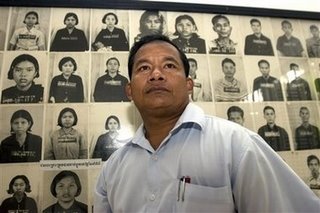Reporting from Phnom Penh

* * * * *
Prosthetic Prowess - by Simon Montlake, Time (USA)
Cambodia hasn't excelled at much lately on the world stage, unless you're ranking countries for genocide and undetected landmines, of which it has an estimated 4-6 million. But the latter, grim though the connection may be, are the reason that the country is competing for a world title at the 2007 Standing Volleyball World Cup, taking place in its capital Phnom Penh. Planned by World Organization Volleyball for Disabled (WOVD), the event runs from Nov. 24 to Dec. 2, and is open to disabled athletes capable of standing, with or without a prosthesis (the WOVD also holds "sitting" volleyball tournaments for wheelchair-bound players). Ranked top in Asia, Cambodia is one of eight national teams competing for a trophy that local artists have fittingly sculpted from melted-down AK-47 assault rifles. Canada, the reigning champion, is the team to beat. The German squad is also highly rated. Out of the running are Afghanistan and Rwanda, who pulled their teams at the last minute, pleading lack of funds. Like those troubled nations, Cambodia has been ravaged by civil strife. The poisonous aftermath still lingers in mine-strewn soil, where the nation's farmers scrape a living. One of the consequences is that there's no lack of amputees keen to strap on an artificial limb and hit a ball over a net. Since 2002, a wet-season disabled volleyball league has nurtured a squad of high-flying semipro athletes who came fourth at the 2005 World Cup in Canada and are gunning for gold on home soil. Christian Zepp, 26, the team's German coach who arrived in September, reckons a place in the finals, or even victory over the favorites, is within reach. "This is our moment," he says.
Not all of Cambodia's volleyball players lost limbs to land mines. Some suffered polio or other childhood diseases, or were maimed by motorbike wipeouts on dangerous roads. Others are ex-combatants with nowhere to go: the Hawks, in the notorious Khmer Rouge stronghold of Pailin, field a mixed team of cashiered former rebels and government soldiers. From eight teams in 2002, the local league has grown to 16 sponsored squads in two divisions who compete for an annual $3,000 prize — a sum that goes a long way in rural Cambodia. Disabled volleyball might sound like a charitable exhibition sport, but don't be fooled, says Neil Wilford, a British adviser to the Cambodian league. When an Australian Navy ship docked two years ago at the southern port of Sihanoukville, its volleyball team agreed to a friendly game against a local disabled squad. Before it started, one of the Australians took Wilford aside and asked how easy they should go on their opponents. "Just play as normal," Wilford smirked. The Cambodians trounced the Australians, spiking ball after ball past the red-faced servicemen. The game has since become an annual fixture.
The National Sports Complex, completed in 1964, is the venue for the WOVD tournament. Designed by the nation's architectural doyen, Vann Molyvann, the Modernist facility was one of the high-tide marks of Cambodia's post-independence achievements, but the nation slid into civil war before it could be properly put to use. Today, the complex is hidden from view by a garish Chinese shophouses that obscure its perimeter walls, but the facilities have been restored. All the matches in the WOVD competition will be played in an indoor stadium and are free to the public. Cambodian Prime Minister Hun Sen, the patron of the disabled league, will preside over the opening ceremony.Staging a successful World Cup is symbolic of Cambodia's sporting rebirth, says Chris Minko, 51, the league's full-time secretary general. Back in the 1960s, then Premier Norodom Sihanouk promoted Phnom Penh as the sporting hub of Southeast Asia, until Indonesia stole his thunder by staging a nonaligned version of the Olympics. Secret U.S. bombings and the Khmer Rouge did the rest. But Minko, a combative, shaven-headed Australian, wants to see Phnom Penh back on top. The first step is victory on Dec. 2, which Minko hopes will help reclaim Cambodia's stature as a sports power to be reckoned with in Southeast Asia. "We're going to bring that back," he says.
* * * * *
Soon to be reporting from Phnom Penh will be author Anne Elizabeth Moore, who is coming to Cambodia in December to explore an underground comics scene few have heard of in order to gain insight into the country and its government. She's been invited to live in an all-women dormitory, set up by the Harpswell Foundation, dedicated to educating Cambodian women. Moore will be a Leadership Resident, and plans to stay at least two months, initially. You can read about her trip at camblogdia.blogspot.com.
Finally, if you are not familiar with the work of Yale University’s Genocide Studies Program, click here. Yale's GSP is instrumental in the study and analysis of atrocities worldwide. In the case of the Khmer Rouge in Cambodia, Ben Kiernan, the program’s director, has made significant contributions to the field. “In 1996, our Cambodian mission discovered over 100,000 pages of secret police files,” said Kiernan. The files included lists of names produced during torture sessions with execution orders at the bottom signed by Pol Pot. GSP was founded in 1994 as the Center for Cambodian Genocide Studies, but Professor Kiernan expanded its mission and changed its name in 1998. Since inception, affiliates of the project have produced ten books and 35 working papers.


0 Comments:
Post a Comment
<< Home